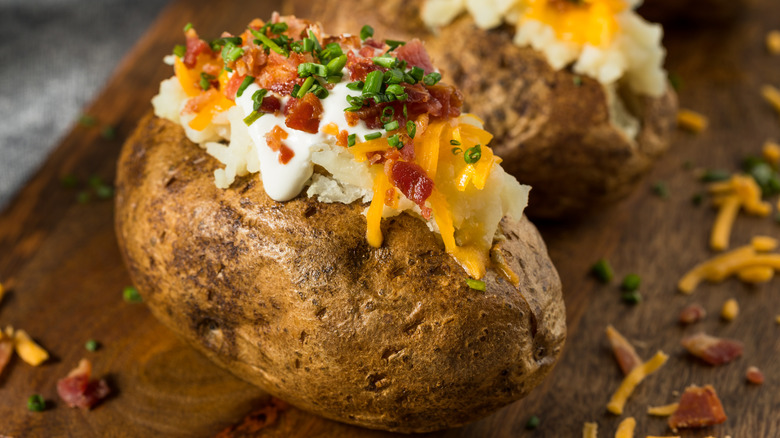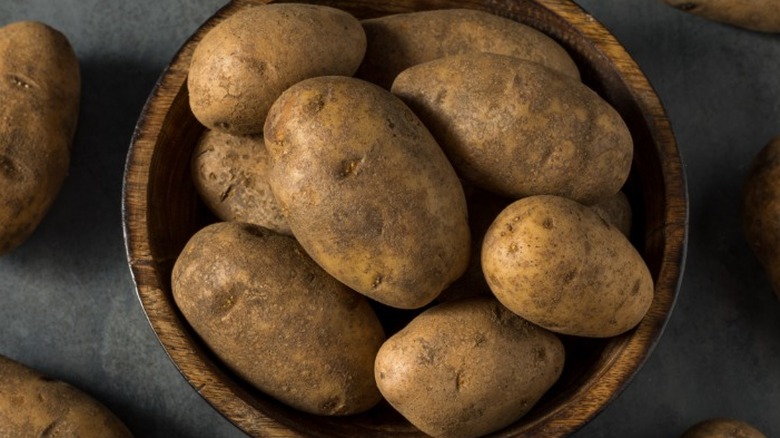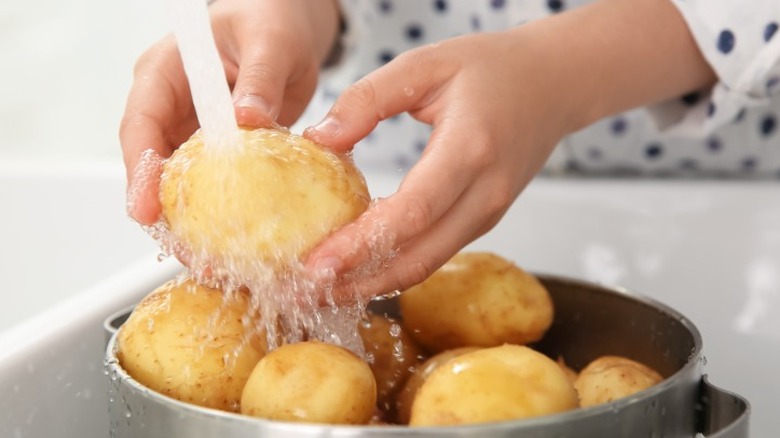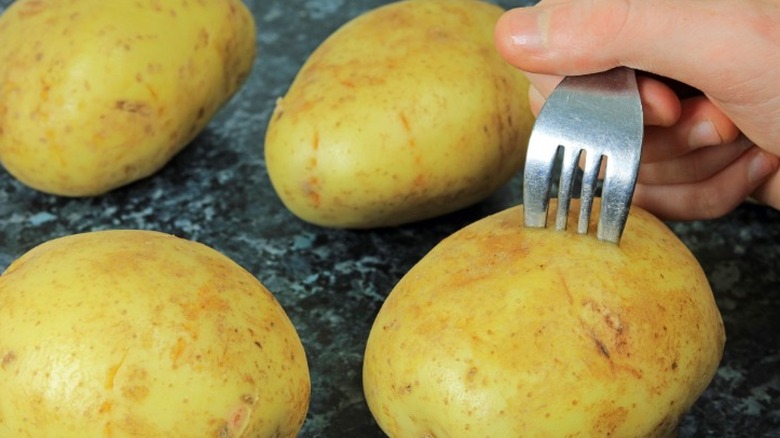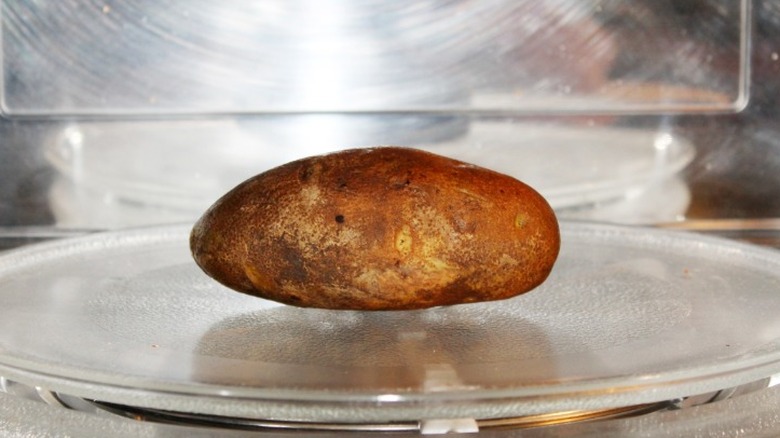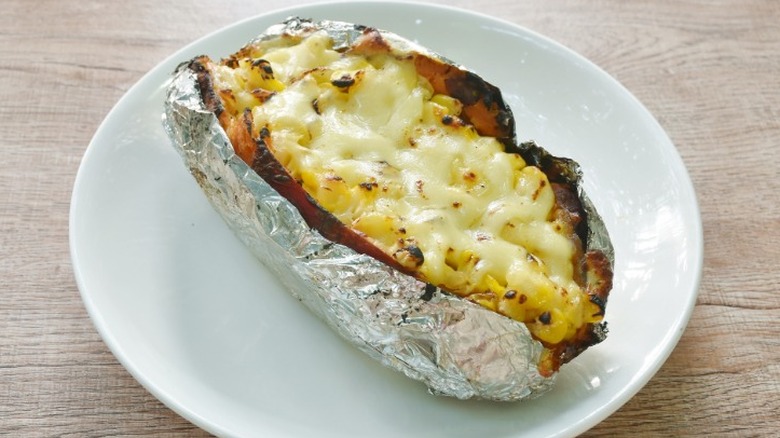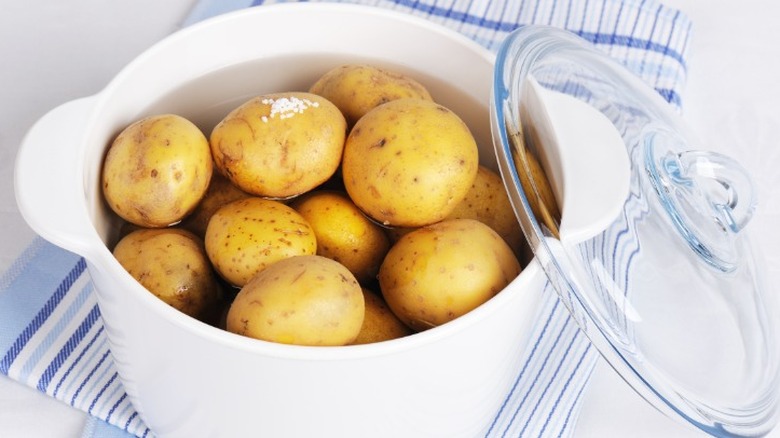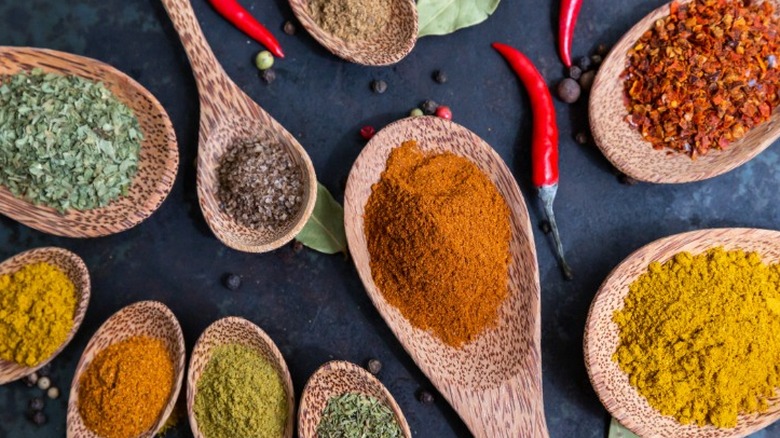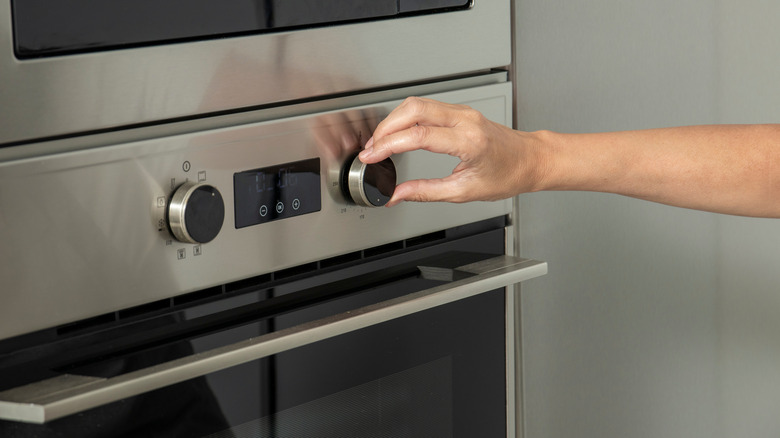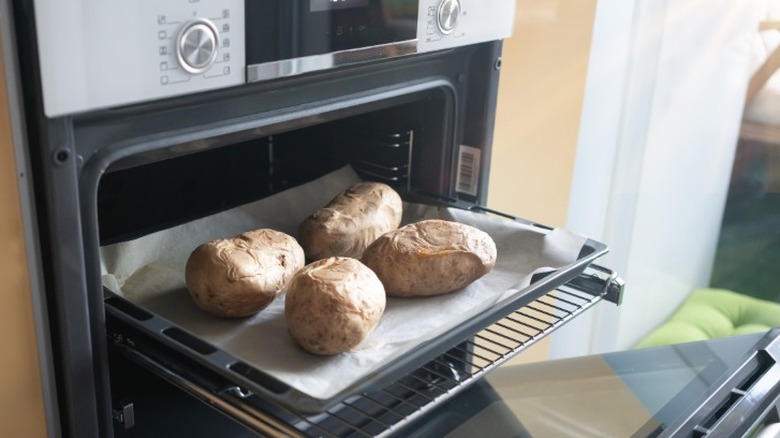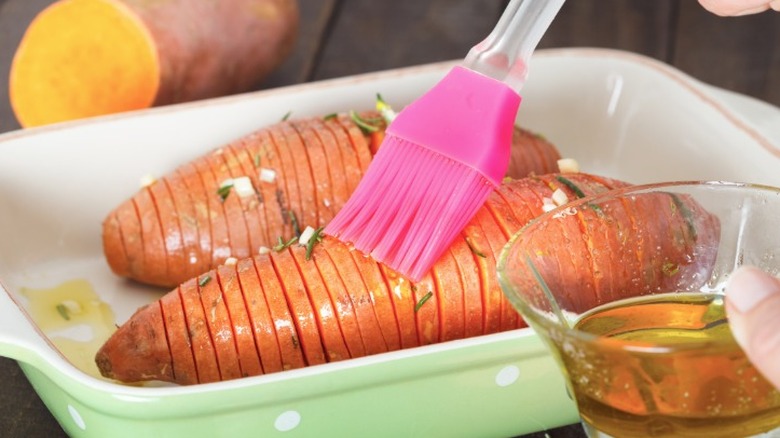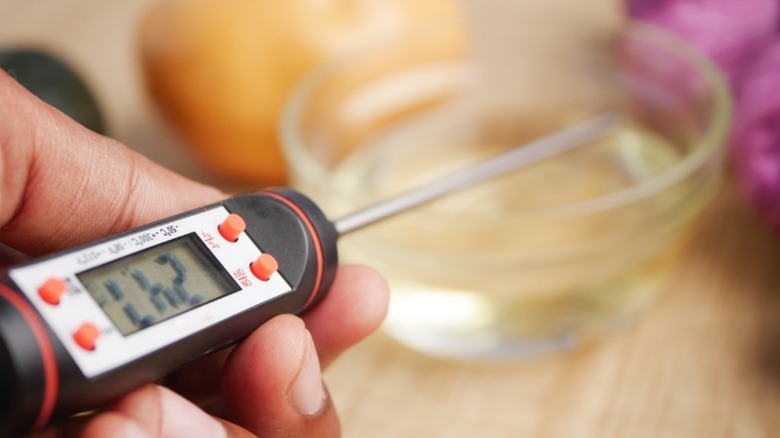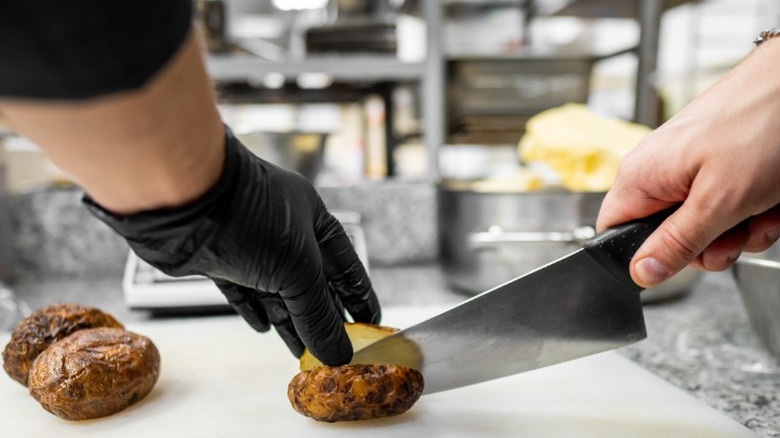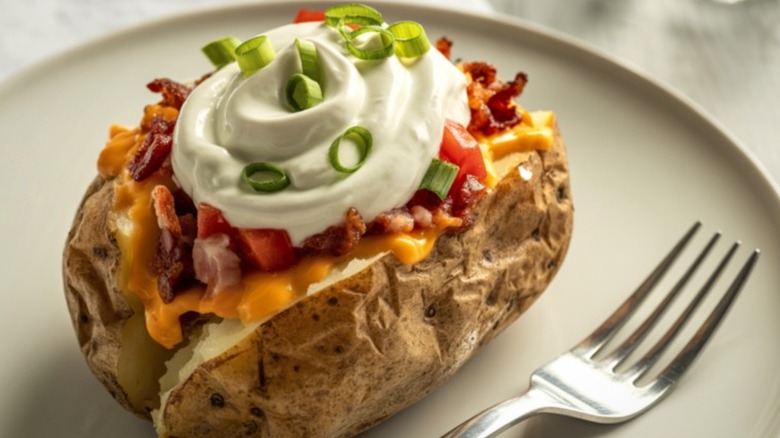13 Mistakes People Make With Baked Potatoes
The star of a meal isn't always a big, juicy steak. Oftentimes, it's the humble baked potato. When cooked correctly, a baked potato is fluffy inside with a crisp exterior, making it the perfect side or main dish. This versatility has made the food a staple throughout history in many different cultures. Thousands of years ago, the Incas cooked their potatoes underground. In 19th century London, street vendors sold 10 tons of baked potatoes per day. And in more recent history, the American-style loaded baked potato has become a mainstay of both homes and restaurants.
Baked potatoes are affordable and don't require many ingredients. But despite their simplicity, it's not always easy to achieve the right texture and taste. Anything from the type of potato you choose to the time spent after baking can turn a good potato into a gummy mess. That's why we've rounded up the top pitfalls people run into while cooking up their spuds, from preparation to post-baking. Avoiding these common mistakes will make sure you end up with the perfect baked potato every time.
1. Not using russet potatoes
You've probably noticed the wide variety of potatoes available for purchase at the supermarket. But there's one variety that reigns supreme when baked and that's the russet potato. Potatoes generally range from low starch to high starch. Russets are one of the high starch varieties, preferred for baking over those with lower starch content. This is because the more starch a potato has, the more its cells separate as it cooks, leading to the drier, fluffier texture characteristics of a baked potato.
Russet potatoes are made up of 20% starch, making it much easier to achieve your desired texture without a ton of extra work. Other types of potatoes like red and Yukon Gold, while still tasty, will result in a denser center that sticks together rather than fluffing up at the touch of a fork. These kinds of potatoes work well in stews or as mashed potatoes but don't hold up as well when baked. So, next time you go shopping, skip the competition and head straight for the russets.
2. Failing to wash and dry the potatoes
Washing your potatoes is an essential first step before the baking process can begin. Potatoes often harbor dirt, bacteria, and even pesticides due to their growing conditions. If not washed away before preparation, this residue can lead to foodborne illness. If you plan to enjoy the crispy skin of a baked potato, a good scrubbing is in order. Just run the potatoes under cool or lukewarm water and scrub thoroughly with a brush. The best part is, if you're using russet potatoes, their thick skin means you can clean away without worrying about ruining them.
However, you should only wash the potatoes when you're ready to use them. Washing potatoes before storing them can cause them to spoil faster. The extra moisture can also lead to mold and bacterial growth. If you do need to work ahead, you can store them in cold water with vinegar after washing for a short period of time. Any longer than that, and you'll want to keep them stored in a dry place until ready to cook. Forgetting to thoroughly dry off the potatoes after washing can negatively impact the texture of your finished dish. The leftover moisture may prevent the skins from crisping up, leaving a soggy exterior. To avoid this, thoroughly dry the potatoes with a paper towel after washing. If needed, leave them to air dry for a while to really wick away all that moisture.
3. Not poking holes in the potatoes
After the potatoes are clean, make sure to poke holes in the spuds. The most commonly cited reason for this is that they may explode in the oven if not properly pricked. While this is a rare occurrence, it can happen. As the potato cooks, steam builds up inside. If there are no holes allowing this steam to escape, pressure builds and the skin may burst, leaving you down a potato and with a mess to clean up. Better to err on the side of safety, especially if you plan to microwave your potatoes before transferring to the oven since pressure builds faster than in the oven.
Many home cooks prick their spuds a couple times and call it a day. Ideally, the potato should be pricked all around its surface, anywhere from eight to 12 times. While explosions are certainly a concern, these holes also ensure that your potato cooks evenly. Steam releases from all sides, avoiding the dreaded partially cooked potato so that each bite is full of fluffy goodness.
4. Not microwaving for a few minutes before baking in the oven
While this next method isn't required, it produces the ideal baked potato texture with the added benefit of making your life easier. Microwaving your potato before baking in the oven allows the potato to steam on the inside, achieving that classic fluffy texture you crave, and avoiding drying out the potato for too long in the oven. Follow that up with a bake in the oven and you'll have a crispy outer skin to go along with it. The amount of time it takes to microwave the potato depends on its size. Generally, start low at around four minutes and add time as needed until a fork can pierce through the potato.
Starting with a partially or fully cooked potato significantly reduces the time it needs in the oven. Cooked only in the oven, baked potatoes can take an hour or more. Using the microwave-first method, can cut this time down to 30 minutes or less. If you microwaved your potato until partway done, place it in the oven for 20 to 30 minutes. If the potato is cooked through and you're just looking to crisp up the skin, pop it in for 10 minutes.
5. Wrapping potatoes in foil
Many grew up with parents or other family members who swore wrapping a potato in foil yielded the best results. However, we now know that this method actually makes it harder to achieve the perfect baked potato. Since all the steam and moisture from the potato is trapped inside by the foil, the crispy skin everyone looks forward to will turn out soggy instead. Leaving the spuds unwrapped allows them to bake correctly and avoid a moist, dense texture.
But foil has more downsides than just preventing a crisp exterior. The foil actually creates an extra outer layer that heat must penetrate through. This means that the potato can take a bit longer to cook than normal. Not using foil also eliminates an extra cost. Why spend extra money buying foil and extra time wrapping up your potatoes when you could cook them in their natural state? Just clean them well and the potatoes will do the work themselves.
6. Failing to brine the potatoes
Brining potatoes may not seem intuitive. More often, this simple technique gives flavor to pork chops and other meats. For this reason, most baked potato recipes skip the step altogether. However, doing so won't accomplish the most flavorful baked potato possible. While brining may sound fancy, it's actually very simple. Just mix 2 tablespoons of salt with a ½ cup of water. The potatoes only need to go in the brine for a few seconds but, if you have some extra time, you can try Guy Fieri's six-hour brine for an elevated potato.
While the potatoes are in the brine, the mixture seeps in through the holes poked in their skin, making sure the flavor spreads throughout the entire potato. Just coating the outside with salt makes it harder for the seasoning to penetrate. Another benefit of brining is that the salt in the mixture helps keep the potato skin dry. This means the baked potato's exterior will be even more crisp and crunchy, with a perfect distribution of seasoning.
7. Forgetting to season potatoes before baking
Don't make the mistake of putting potatoes in the oven plain. If you've ever wondered why restaurant baked potatoes always taste better than homemade, seasoning may be the culprit. To start, salt is a must. Evenly and thoroughly coating potatoes with salt yields a crisp outer layer thanks to the seasoning's crystallization in the oven. But don't be afraid to try other seasonings as well. Ina Garten, for example, combines salt with fresh herbs and lemon zest to create a unique depth of flavor.
If you don't have fresh herbs on hand, dried ones will do fine. Even just a touch of black pepper or garlic powder can take your baked potato to the next level. Experimenting with different seasoning blends also means you can pair your baked potato with all sorts of meals. Try Elote seasoning for a Tex-Mex dinner, or add paprika and other herbs for a Spanish-style potato. Treat the potato as a blank slate and the options are endless.
8. Not choosing the right oven temperature and time
When your potatoes are ready to hit the oven, choosing the right temperature and time for baking is crucial. High heat for a longer period of time is the way to go for baked potatoes. Ideally, the oven should be preheated to 400 degrees Fahrenheit. Preheating is essential as not doing so can result in longer cooking times and uneven baking. Cooking the potatoes at too low of a temperature will take longer. It can also dry out the potato and leave a leathery skin. Similarly, cooking at too high of a temperature runs the risk of burning your potato's exterior.
Once the oven is heated to the ideal temperature, you'll want to bake it for around 45 minutes to an hour. Since potatoes are very dense, it takes a while for the heat to penetrate the entire vegetable. Cutting the time short can result in a potato that isn't fully cooked. Aiming for 45 minutes allows the inside of the potato to cook evenly without burning the outside in the process.
9. Baking potatoes on a baking tray instead of a wire rack
Just as the common foil mistake can compromise a potato, so can the surface it's baked on. Avoid using a baking tray to cook potatoes on. Baking trays prevent the oven's heat from reaching all parts of the potato which is one reason why your perfect baked potato keeps failing. As some areas are exposed to more or less heat, the potato ends up unevenly cooked. Another issue with these trays is that they conduct heat in a way that may leave dark, overcooked spots on your potatoes.
The solution to these problems? A wire rack. The holes in a wire rack allow heat to circulate evenly, cooking each part of the potato equally. An easy way to take advantage of this cooking method is to place the unwrapped potato straight onto the oven rack. A tray or foil sheet can be placed on the rack below to catch any excess seasoning or oils during cooking. If you still want to make use of those baking trays you have laying around, you can also place a wire rack on top of the tray. Since the potato isn't in direct contact with the baking sheet, the heat is still able to crisp up its entire surface.
10. Not using oil to crisp up the skin partway through baking
Oil is a great way to get crispy skin on a baked potato. But be sure to oil up the potatoes at the right time. Many people brush their potatoes with oil right before putting them in the oven to bake but this actually defeats the purpose. The oil forms a layer on the outside of the potato that traps all the moisture that escapes while the potato is cooking. With nowhere else to go, the moisture seeps into the potato and by the end of baking, the skin is soggy and chewy. Instead, allow the potato to cook through fully. Then, pull the potatoes out, brush them with oil, and place them back into the oven for a quick 10 minutes to crisp up.
Some might be tempted to replace the oil in this step with butter. But save that rich buttery goodness for after baking. Butter has a high water content which creates more of that dreaded moisture, preventing the potato's skin from crisping in the oven. For a better oil substitute, try brushing the potatoes with some rendered animal fat, such as bacon fat or duck fat.
11. Not using a cooking thermometer
The key to the perfect interior texture on a baked potato is checking its internal temperature during cooking. Squeezing the potato or using a toothpick and fork isn't enough to know if your potato is ready. Squeezing, in particular, can be deceiving as the outside may feel done while the center is still uncooked. Using a cooking thermometer gives a more accurate reading on the potato's level of doneness. Monitoring the temperature of the potato throughout the baking process helps prevent both under and overcooking your spuds. Also, different sizes of potatoes can impact their cooking time.
Ensuring that the potatoes meet a certain temperature yields consistent results even when your potatoes aren't all clones of each other. That key temperature is right around 205 degrees Fahrenheit. At this temperature, the potatoes are light and fluffy on the inside, and cooked all the way through. Although 205 degrees Fahrenheit is the goal for a good baked potato, there is still some wiggle room. Anywhere up to 212 degrees Fahrenheit will get you the ideal texture you crave.
12. Failing to cut the potato straight out of the oven
Resting meat is a common tip to ensure that the cut stays juicy and tender. However, baked potatoes actually lose some of their good qualities the longer they rest without slicing. These delightful spuds should be cut open right out of the oven to maximize their flavor and texture. If not cut open immediately, even with the holes poked in them prior to baking, the majority of the steam from baking remains inside the potato. The longer it sits, the more time there is for the moisture to seep in and turn the inside gummy. The crispiness of the skin will also suffer from the excess water. No matter how well the baked potatoes were cooked, skipping this step can undo all that hard work.
So when your potatoes have finished cooking, simply take them out of the oven and slice them down the center, to allow all the trapped steam to escape. Make sure to use an oven mitt or towel since the potatoes should still be piping hot. Give them a gentle squeeze to fluff up the inside. By the time you're ready to serve them, the potatoes will be the perfect temperature to dive right in and enjoy.
13. Not loading up on toppings
The potatoes are ready to serve. While they are tasty on their own, skimping out on toppings does a real disservice to the dish. Baked potatoes make a great base for all sorts of garnishes. Plus, they're easy to customize to whatever preferences or dietary needs you and your guests might have. The options range from simple to extravagant. If you're looking to replicate the classic restaurant–style loaded baked potato, for example, the star toppings will be butter, chives, and sour cream. Adding a sprinkling of bacon bits to the top takes it a step further. Even the butter itself can be elevated by adding a few ingredients to make a compound butter — anything from herbs to chili peppers can be good to add in.
Toppings don't have to break the bank or take forever to prepare, either. There are plenty of canned foods that make delicious baked potato toppings. Canned tuna and baked beans are popular choices, especially if you're aiming for a British-style jacket potato. Canned soups and chili can turn a baked potato into a hearty meal that will keep you satisfied for longer. And vegans can also join in on the fun without missing out on flavor by topping their potatoes with assorted vegetables and lentils. Even crispy chickpeas are easy to make for added texture. Whatever toppings you choose will be the cherry-on-top of a perfectly baked potato.
